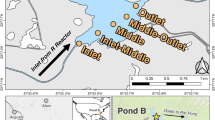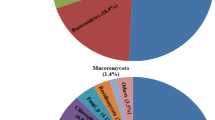Abstract
Spontaneous burning of bituminous shales at the Smoking Hills in the Canadian Arctic has produced intense acidic fumigations and strongly influenced the local tundra. The burns are of great antiquity. In an area of typically alkaline ponds with pH above 8.0, ponds within the fumigation zone have been acidified below pH 2.0. Elevated concentrations of metals (aluminium, iron, zinc, nickel, manganese and cadmium) occur in these acidic ponds. Soils and sediments have also been chemically altered. The biota in the acidic ponds are characteristic of acidic environments worldwide, in contrast to the typically Arctic biota in adjacent alkaline ponds.
This is a preview of subscription content, access via your institution
Access options
Subscribe to this journal
Receive 51 print issues and online access
$199.00 per year
only $3.90 per issue
Buy this article
- Purchase on Springer Link
- Instant access to full article PDF
Prices may be subject to local taxes which are calculated during checkout
Similar content being viewed by others
References
Franklin, Sir, J. Narrative of a Second Expedition to the Shores of the Polar Sea: 1825–1827 (Murray, London, 1828).
Selwyn, A. R. C. Report on Explorations in British Columbia (Geological Survey of Canada, 1877).
Henderson, G. Geol. Surv. Greenland Rep. 22, Copenhagen (1969).
Rosenkrantz, A. Grønland 12, 377–384 (1977).
Havas, M. thesis, Univ. Toronto (1980).
Almer, B., Dickson, W., Ekstrom, C., Hornstrom, E. & Miller, U. Ambio 3, 330–336 (1974).
Gjessing, E. T., Hendriksen, A., Johannessen, M. & Wright, R. F. SNSF Proj. Res. Rep. FR6/76 (1976).
Dillon, P. J. et al. J. Fish. Res. Bd Can. 35, 809–815 (1978).
Brock, T. D. Science 179, 480–483 (1973).
Lackey, J. B. Public Hlth Rep. 54, 740–746 (1939).
Joseph, J. M. Ohio J. Sci. 53, 123–127 (1953).
Warner, R. W. Ohio J. Sci. 71, 202–215 (1971).
King, D. L., Simmler, J. J., Decker, C. S. & Ogg, C. W. J. Water Pollut. Cont. Fed. 46, 2301–2315 (1974).
Yoshimura, S. Archiv. Hydr. 26, 197–202 (1933).
Negoro, K. Jap. J. Limnol. 9, 176–179 (1939).
Ueno, M. Verh. int. Ver. Limnol. 13, 217–226 (1958).
Wright, R. F. & Gjessing, E. T. Ambio 5, 219–223 (1976).
Conroy, N., Hawley, K. & Keller, W. Rep. Water Resources Assessment, North-eastern Region (Ministry of Environment, Ontario, 1978).
Schofield, C. L. Ambio 5, 228–230 (1976).
Baker, J. P. & Schofield, C. L. in Proc. int. Conf. Ecological Impact of Acid Precipitation, Norway (eds Drablos, D. & Tollan, A.) 292–293 (SNSF Project, 1980).
Hendriksen, A. Nature 278, 542–545 (1979).
Hendriksen, A. in Proc. int. Conf. Ecological Impact of Acid Precipitation, Norway (eds Drablos, D. & Tollan, A.) 68–74 (SNSF Project, 1980).
Gizyn, W. I. thesis, Univ. Toronto (1980).
Norton, S. A. in Proc. 1st Int. Symp. Acid Precipitation Forest Ecosystem, 711–718 (USDA Forest Service, General Tech. Rep. NE-23, 1976).
Sheath, R. G., Havas, M., Hellebust, J. A. & Hutchinson, T. C. Can. J. Bot. 60, 58–72 (1982).
Cassin, P. E. J. Phycol. 10, 439–447 (1974).
Hargreaves, J. W., Lloyd, E. J. H. & Whitton, B. A. Freshwat. Biol. 5, 563–571 (1975).
Tamura, T. Jap. J. Limnol. 6, 63–73 (1936).
Gorham, E. & Gordon, A. G. Can. J. Bot. 41, 371–378 (1963).
Havas, M. & Hutchinson, T. C. Can. J. Fish. Aquat. Sci. 39, 890–903 (1982).
Havas, M. & Hutchinson, T. C. Can. J. Zool. (in the press).
Lackey, J. B. Publ. Hlth Rep. 53, 1499–1507 (1938).
Jernelov, A., Nagell, B. & Svenson, A. Holarctic Ecol. 4, 116–119 (1981).
Hutchinson, T. C., Nakatsu, C. & Tam, D. Int. Conf. Heavy Metals in the Environment, Amsterdam, 300–304 (CEP Consultants, Edinburgh, 1981).
Author information
Authors and Affiliations
Rights and permissions
About this article
Cite this article
Havas, M., Hutchinson, T. The Smoking Hills: natural acidification of an aquatic ecosystem. Nature 301, 23–27 (1983). https://doi.org/10.1038/301023a0
Received:
Accepted:
Issue Date:
DOI: https://doi.org/10.1038/301023a0
This article is cited by
-
Response of zooplankton, benthos, and fish to acidification: An overview
Water, Air, & Soil Pollution (1995)
-
Acidification of lakes in Šumava (Bohemia) and in the High Tatra Mountains (Slovakia)
Hydrobiologia (1994)
-
Impact of heavy metals on an arctic rhizobium
Bulletin of Environmental Contamination and Toxicology (1991)
-
Extreme metal and acid tolerance ofEuglena mutabilis and an associated yeast from Smoking Hills, Northwest Territories, and their apparent mutualism
Microbial Ecology (1988)
-
Effects of experimental acidification on a lotic macroinvertebrate community
Hydrobiologia (1987)
Comments
By submitting a comment you agree to abide by our Terms and Community Guidelines. If you find something abusive or that does not comply with our terms or guidelines please flag it as inappropriate.



